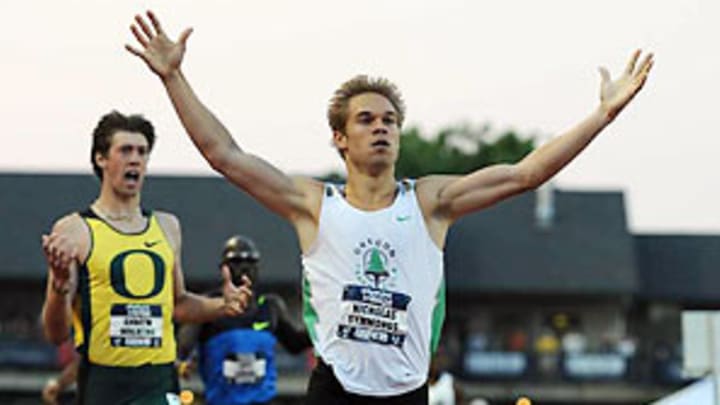What I'm looking forward to...


What most to look forward to in Beijing? This is an easy one for all you out there who, like me, watched every final at the U.S. Track and Field Trials in Eugene, Ore., at least twice (you know who you are, you Letsrun.com message-boarder, you):
The men's 800 meters.
You don't have to be an interval ideologue or a plyometrics pundit to have felt your heart racing along with the field of the 800 final in Eugene. You don't even have to be a track fan. You just have to be alive -- as in, if that race didn't get you excited, better check your pulse.
When a friend and I forcibly exposed a dozen sports dilettantes to a replay of that race, two of them asked, amid the gasps of others, "How did he do that?" in reference to Nick Symmonds, who sidled out of seventh place with 160 meters to go and bolted to the lead so quickly that, as he put it, he had a full straightaway to think about how to celebrate when he finally floated across the line. (He went with arms raised skyward, transitioning to double biceps flex).
For U.S. fans, the 800 is a bit of a lost event at the Olympics, a distance between the glitzy sprints -- in which Americans flood the medal stand -- and the longer contests that are familiar to recreational runners from road races. The fact that an American athlete hasn't made the 800 final in the last two Olympics contributes to the event's stateside obscurity.
Nonetheless, it remains the most dramatic of contests. Because the 800 is the fastest event in which runners break from their lanes, it's the most tactical of all races, and rivals the marathon for unpredictability. The two-lap race generally comes down to frantic jockeying for position about 300 meters from the finish, which sets up an all-out anaerobic sprint, frequently with several runners coming across the line completely exhausted and shoulder to shoulder.
At the Trials, two such coupled Olympic hopefuls dove for the final qualifying spot, one dream left face down on the track and the other affirmed by six-hundredths of a second. That's the 800. One moment too long hugging the rail and you're stuck; swing wide one meter too far and watch the pack slip past on the inside; one second of hesitation, and it's over. No time to think. It is act, and react, or you are lost.
That predicament breeds panic in some runners who, despite fast times, perform erratically at important meets. Symmonds, though, is able to keep his calm, even in last place, patiently waiting for the moment when he can unleash a kick suddenly enough and late enough in the race that his competitors are hard pressed to respond.
It reminds me (at least via YouTube, since I'm not old enough to have seen the race) of another American half-miler: Dave Wottle. Wottle won gold with a ferocious, and nerve-wracking, kick in the 800 in 1972. He was so far back at one point that an announcer questioned whether he was lagging strategically or whether he was "seriously injured."
Wottle was the last American half-miler to stand atop the podium, and the man himself is excited for the first time in "quite some time ... about the prospects of the U.S. men in the 800 meters." Said Wottle: "I believe that often the Olympics are more a matter of destiny than talent. As you can imagine, I've always had a soft spot in my heart for kickers."
Symmonds is ranked 10th in the world based on time, and thus can't currently be compared to Wottle, who tied the world record at the trials before the '72 Games. But Symmonds, like his late kicking forebear, win or lose, is must-see TV.
